Hello everyone. Greetings. I’m gonna talk about some extremely old dicks. First, some Please Claps and Important Links:


Jiminy Crimbo that’s a bad one. While we’re standing here humbled in front of Mask Wall, a word to some of my fellow New Yorkers who are for some inexplicable reason horny, on main????, for Cuomo. What I suspect you are horny for is the illusion of control, of him having it “handled,” which yeah I understand is lucrative compared to most other politicians right now. But Y are you forgetting he’s a politician? Why are you stanning any politician? (Go back a few newsletters if you want to read more about this—it’s about Taylor Swift and Nancy Pelosi, my queens.) Don’t look at his actions, DO CLAP for his Mask Wall! MASK WALL!!!!!

And: How Cuomo is using the pandemic to consolidate power. And from friend of the page Danielle Tcholakian: No, Andrew Cuomo Isn’t the Hero We Need.
Check out this inspiring message:
Other things: don’t cross picket lines! And give your money away.
> Celebrating May Day Starts by Taking Workers Seriously
> Donate directly to undocumented immigrants
plus: why is time moving so weirdly? Send tweet - every single non-disabled person ever. Here’s a thought:


Also, check this out! Chronic illness inclusion project.
Time for the promised Olde Dicks.
Our special Monster of the Week episode: Penis marginalia.
I posted recently that I had a Tinder update and included a bunch of PP marginalia circa the 14th century. Were you not entertained? YOU WERE. And I learned so much from you all in the comments, a blessed reminder that the comments can sometimes be good. Including:
“I went to a v interesting talk on Medieval Penis Trees, which basically concluded they were often depicted as propaganda, i.e. ‘if these other people take power, witches are going to put your dicks in trees and anal sex WILL occur”
“The classic example is the Malleus Maleficarum, The Hammer of Witches, the authoritative guide to when you’ve got a witch problem on your hands. Part II, 118A-D. In which inquisitors consider whether it is true that witches may steal men’s penises and keep them in nests in boxes in trees where they wiggle about and eat grain.”
“Have you heard of Herms? Or phallos birds?”
“If you are not already aware of the related genre of erotic pilgrimage souvenirs, google medieval sex badges.”
I was going to say that this marginalia interlude is wholly unrelated to my supposed, current newsletter theme of “where did that art come from” but alas, what is more “where did this art come from?” then delving into early book-making, reminding ourselves how many invisible hands are part of any book, how the multiplicity of many hands are collapsed—now, not then—behind the fallacy of a single, notable creator? It is never so simple, and never so solitary, but we like to think of individuals as being Solitary Geniuses, rather than people with collaborators. Spoiler, everyone needs help, individuals are never working alone. Etc. etc.
I have long been fixated on marginalia (like many of us readers and writers) for how visceral a reminder it is of texts being alive. It’s an undeniably twee truth that we can’t get enough of the palimpsests others have left for us, basking in the delicious potential of being able to add ourselves into the margins, too. Is this…immortality?
Ok but: Marginalia is, broadly speaking, anything written or drawn in the margins of a text. Let’s see some medieval marg stat:

ID: A grotesque image of an ogre shooting an arrow into another creature’s rear from the Rutland Psalter, c. 1260. (British Library Royal MS 62925, f. 87v.). Taken from this article.
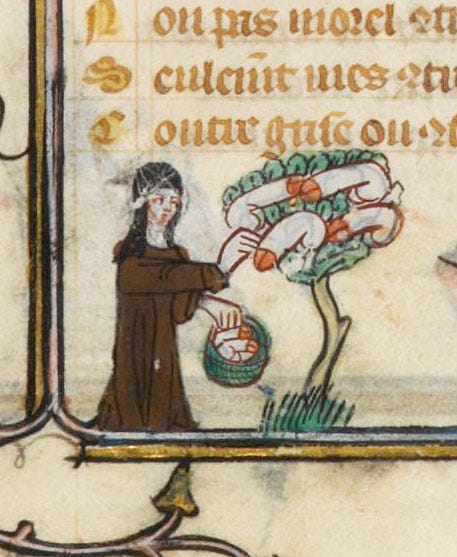
ID: A nun plucks penises off a phallus tree in the Roman de la Rose, c. 1325-1353. (Paris, Bibliothèque nationale de France, MS. Fr. 25526, f. 106v.)
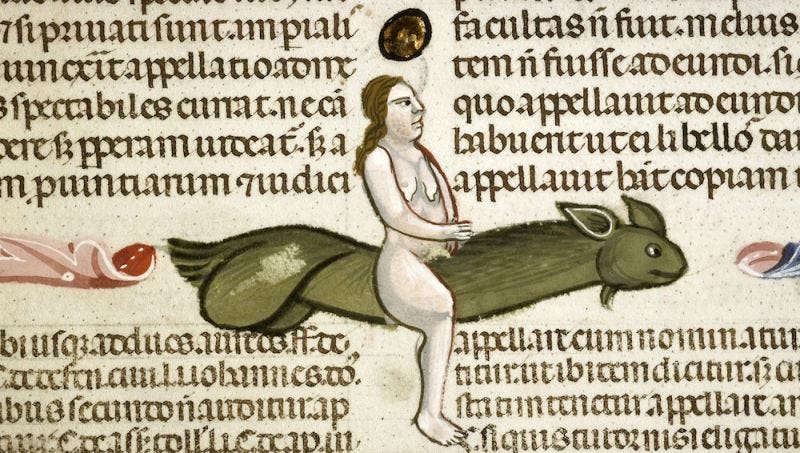
ID: a nude person rides on what looks like a very pleased green dick, in and around the existing text. Sourced from here.
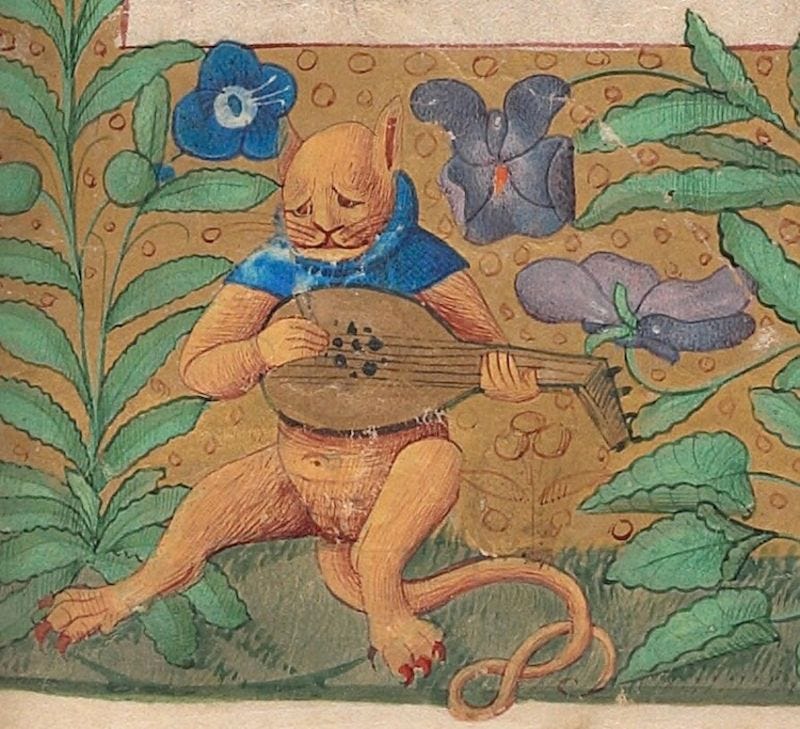
ID: VERY sad…cat? Plays a lyre
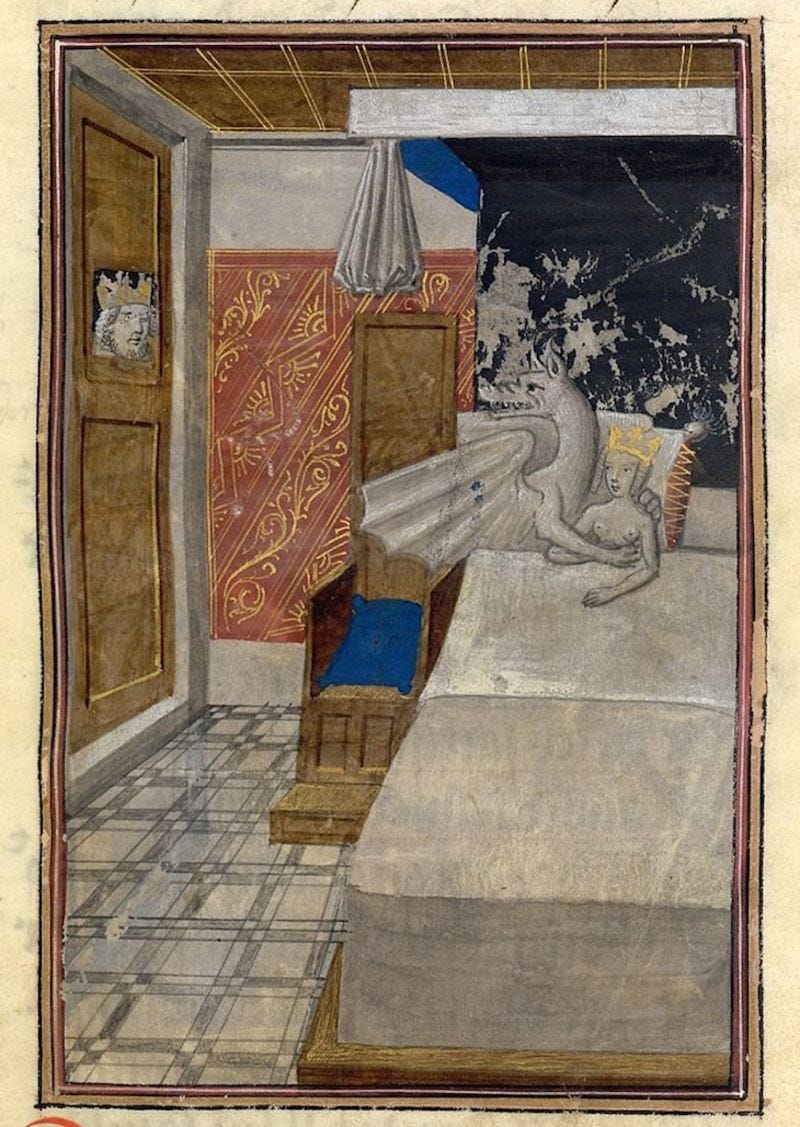
ID: a king catches his wife cheating on him with a dragon. They are in bed together! The dragon and the queen!
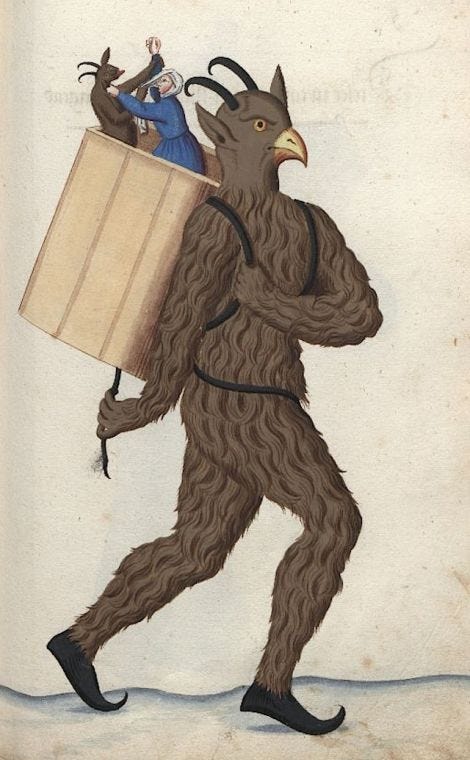
ID: Big strong maybe admittedly a little sexy Bird Man carries a backpack, within which a woman and smaller (Weak) bird man fight.
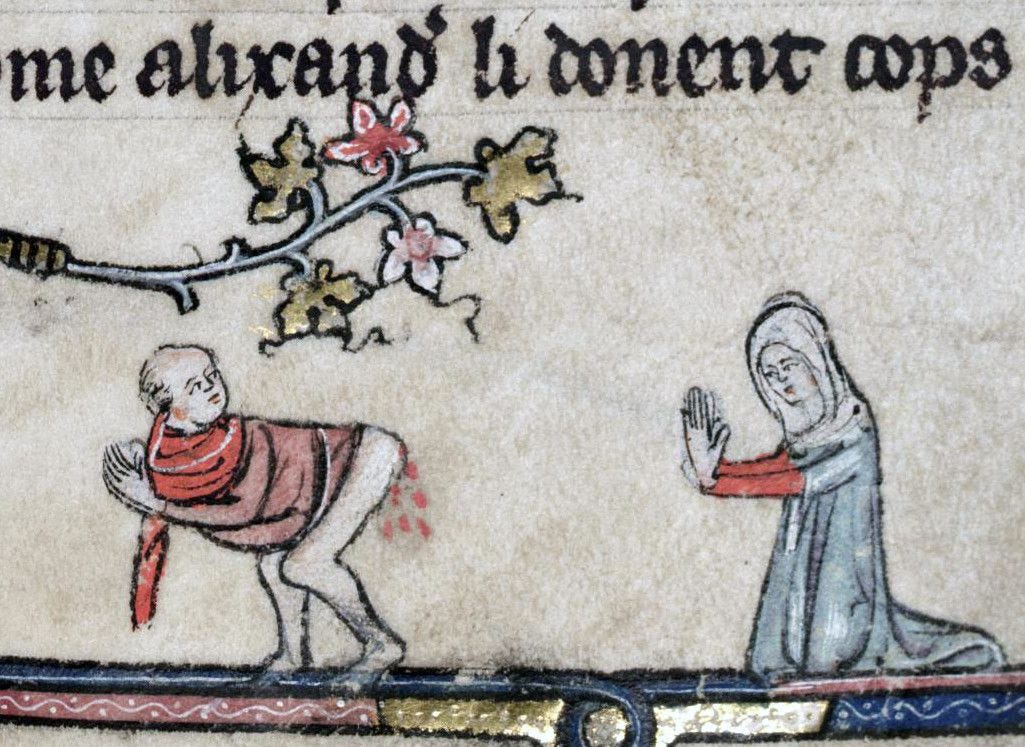
ID: a nun tells a man bleeding out of his bottom ‘no more’ by putting her hands up in front of her as though she could stop the bleeding butt.
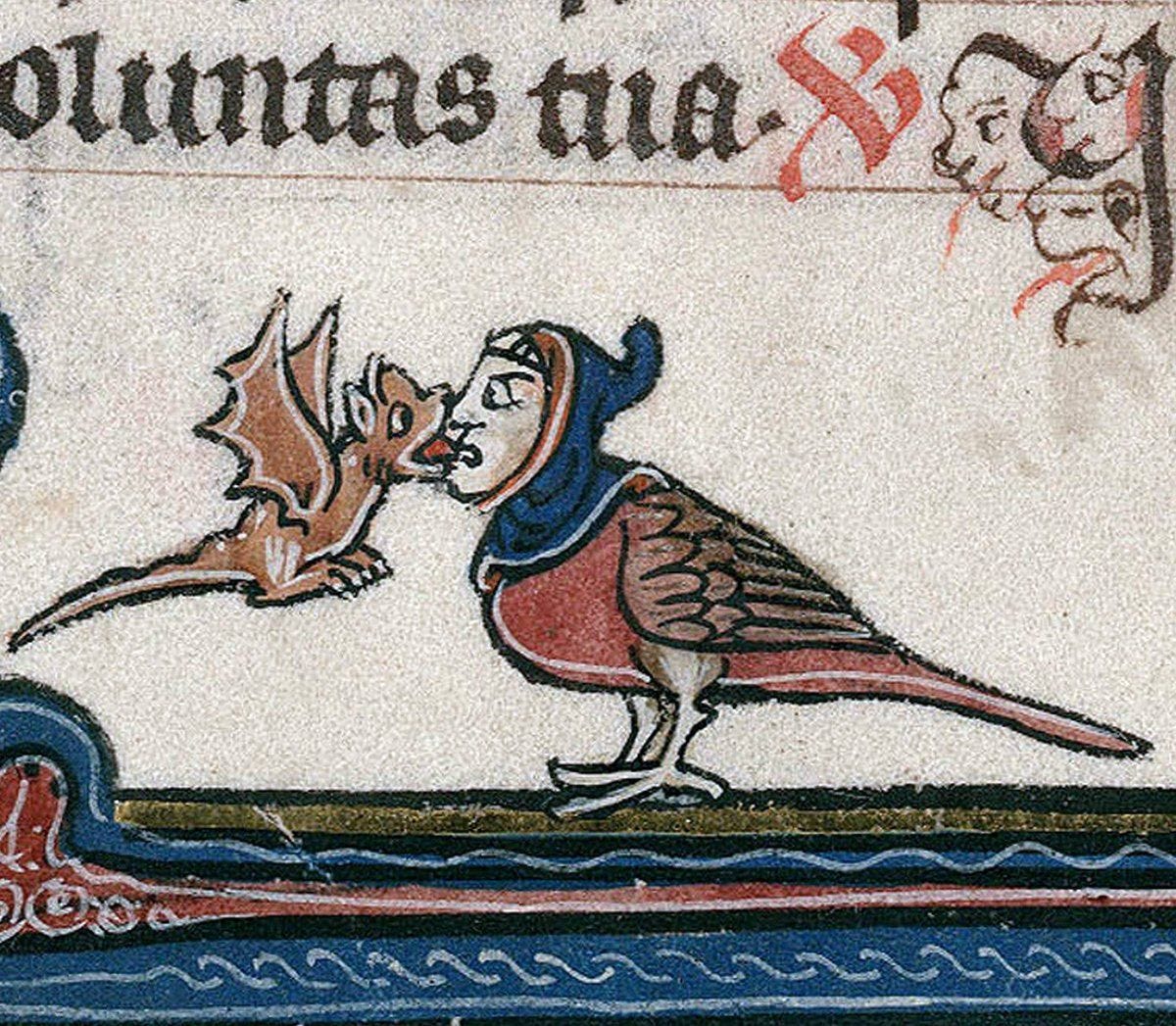
ID: a bird with a man’s face locks lips (or shares a strawberry) with a small dragon.

ID: a ballsack wearing a jaunty beret plays a little horn.
In the blog post roundup version articles about these images, i.e. SEO friendly headline bout a slideshow of old dicks, they seem to ascribe most of this marginalia to the whims of bored monks, complaining to each other in the margins as they had to painstakingly copy texts by hand.
I did find that there were bored monks basically kvetching back and forth to each other via marginalia, which is incredible. This Books Tell You Why blogpost (yes, here I am, on the interwebs) categorizes such marginalia into “complaints” and “curses.” But while there are a few broken links around to translations of the outright complaining and/or curses, it seems a great deal more of the illustrations were either designed to subvert the text (and commissioner) more artfully, or were designed to accompany the text itself. (One blog I found suggested early explanations for all marginalia could be chalked up to “horror vaccui” - a fear of emptiness which “presumably required them to fill empty pages at random.” I love this. What a profound metaphor for our time.)
But as my favorite blog discovered during this search Got Medieval fervently articulates after being erroneously described in the New Yorker blog as archiving “marginalia doodles” (gasp) the author clarifies that one does not SIMPLY doodle with GOLD LEAF???? Our dude here makes a great case for the differences between reader-added doodle and/or musing, and what are clearly larger mechanizations between those working on the book and those commissioning the book.
This Atlas Obscura piece talks in great detail about a medical text with what are clearly intentional illustrations. Thus still technically marginalia, but very distinct from the overarching narrative of “ a bored monk was here.”
So if these weren’t bored doodles, what are we to make of all the, uh, erotic imagery? In what are often religious texts? Again on the medieval manuscripts blog, the author writes that while there was likely criticism of the images at the time—that they were too profane, what is this penis doing with a cap—most patrons found value in them. “The margins may have been a safe place for subversion against cultural norms, a sort of carnival on the page. They might serve as demonstrations of artistic skill, or as creative parody, intended to evoke the laughter that they still succeed in drawing from us today. Many kinds of marginalia also functioned as additional commentary on the text that they surround, or as anti-examples, moral guides about what not to do.”
Interlude: I previously thought the Restoration Monkey Jesus was the best botched art job, but I found another contender: a 13th century phallus tree fresco that was EDITED BY RESTORATIONISTS TO HAVE LESS DICK. Here’s a real quote about it: “The experts who carried out the restoration have been accused of sanitizing the mural by scrubbing out or altering some of the testicles, which hang from the tree’s branches along with around 25 phalluses.”
Ok moving on (this is all very cursory, just want to show you the images and send you off on your own research journey, what a fun world) to sex badges, which thank you comment section for the tip. Really on brand for me, as the Internet’s Only Award Giver. Bow to me.

“Erotic pilgrim badge, Netherlands. This pewter badge dates to the late 14th/early 15th century and depicts a vulva dressed as a pilgrim. Such images were believed to lure evil spirits away from the pilgrim.” It is a vulva wearing a small traveling cap and holding a staff.
My extremely cursory 3-am research suggests that, similarly albeit even more indecipherable than the marginalia in terms of specific meaning, it’s quite possible that my response of “is that Gandalf” to this Vulva wearing a traveler’s cap and holding a staff was probably not the reaction at the time. I did spend a while reading this article by Ben Reiss entitled, “Pious Phalluses and Holy Vulvas: The Religious Importance of Some Sexual Body-Part Badges in Late-Medieval Europe” which shed light on how these symbols were probably not laden with the implicit eros that we ascribe now.
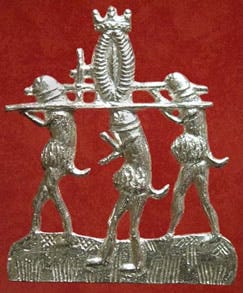
ID: a bunch of walking dicks carry a vulva on a throne

ID: A dick farmer (?) pushes his wheelbarrow of dicks while standing on top of what is a much bigger dick.
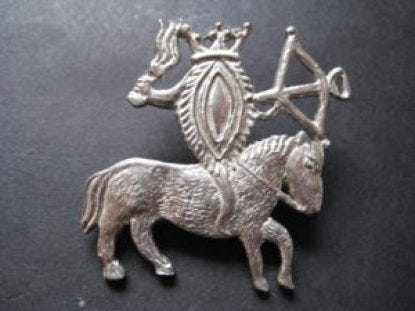
ID: A valiant vulva in a crown rides a horse and holds a bow and arrow.
This paper is a goldmine. I do recommend reading it. According to the paper, researchers A.M. Koldeweij and Malcom Jones suggest these sexual badges “were used as amulets or charms or satirized religion,” though they “stop short of assigning them any pious Christian meaning.” In a late-medieval world, “sexual imagery was not uncommon, even in religious contexts.” The badges and marginalia both may have been to ward off evil spirits, which yeah, tracks with me. The badges? This marginalia? They contain multitudes. I.e. it’s clear there was some latent humor, but they were also likely filled with meanings we cannot grasp. And I love that.
One article I couldn’t open because of a paywall seemed prescient. It was about the use of these “bawdy badges” and the Bubonic Plague.
Ultimately, this thesis argues that the bawdy badges functioned as apotropaic, or protective devices, meant to safeguard their owners from the threat of the evil eye, which during the worst outbreaks of the Bubonic Plague, was thought capable of transmitting the disease.
In everything I read about the badges, too, they were found by water. Not in normal trash sites where other medieval shit was found. But “water sites throughout the Schelde Estuary in the Netherlands, the riverbanks of the Seine in France, and the Thames in England.”
Imagine being the archeologist who found this Gandalf vulva. It is truly a treasure. But on a loosely poetic note to tie to our current moment: imagine lovingly burying this potential symbol meant to ward away evil, perhaps worn during a plague. Imagine that there was an after. A moment wherein the object had served its purpose and was left, lovingly, delicately, by the water.
Enjoy your internet travails + google some more about this.
With love and dreams of dick marginalia,
Shelby + Clem





suck
i have boobs